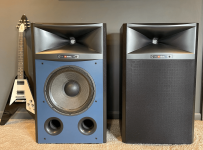Hi all,
I guess I better post a new thread…
I have a single JBL 4367 plastic horn that is 22-1/16” wide and about 10” deep. Since I have no idea how to replicate it I imagine I can 3D scan it and use the file to print a copy or a pair.
Can anyone help with advice? Can it be done with an iPhone or I need a special high resolution scanner? Thanks in advance!
I guess I better post a new thread…
I have a single JBL 4367 plastic horn that is 22-1/16” wide and about 10” deep. Since I have no idea how to replicate it I imagine I can 3D scan it and use the file to print a copy or a pair.
Can anyone help with advice? Can it be done with an iPhone or I need a special high resolution scanner? Thanks in advance!
The iPhone does have depth perception but 3D scanning is usually more sophisticated than that. Ordinarily I'd prefer to study and draw it myself.
I think if there's any doubt you might better guarantee a match if you printed both horns. It might even give you the chance to revisit the design. Perhaps increase the height if that's something you'd want.
I think if there's any doubt you might better guarantee a match if you printed both horns. It might even give you the chance to revisit the design. Perhaps increase the height if that's something you'd want.
If you post a picture of the horn front and back perhaps one of us CAD jockeys can create a parametric model of its basic features, for you to confirm and edit later?
I had some success by molding a negative form from axisymmetric waveguides with playdough or plaster, either making a linear "cast" through the horn center axis or by cutting a complete plaster form (be very careful when cutting plater! don't ask why I know!).
play dough should be applied at one cutting plane through the horn axis, then put the horn with play dough in the freezer to make play dough hard enough to remove it from the horn after some minutes.
potato starch can be used as release agent.
after that the play dough "section" can be scanned with high resolution and copied with CAD.
here is a quite mediocre scan done from a "play-dough-section" from home-made waveguide:

of course you could also make a negative form with plaster and use it to copy it with plastic material.
I freely followed the suggestion on rod elliott's site, using "polymer clay":
https://sound-au.com/articles/waveguides3.htm#s8
here are some images ...
negative "turned" waveguide form:
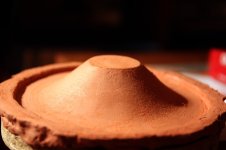
the "polymer clay" copy after filling:
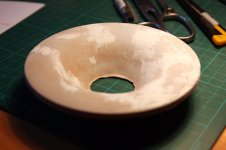
... and painted:
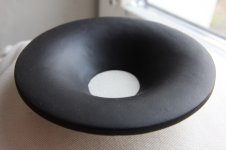
and a partial (short) plaster copy of an existing waveguide (WG300):
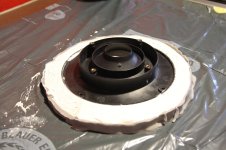
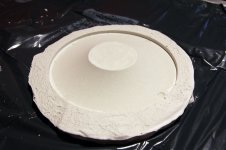
and a too thin and very rough polymer clay copy - next time I need to be much more generous with the copy material.
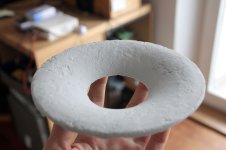
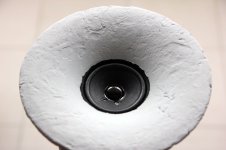
play dough should be applied at one cutting plane through the horn axis, then put the horn with play dough in the freezer to make play dough hard enough to remove it from the horn after some minutes.
potato starch can be used as release agent.
after that the play dough "section" can be scanned with high resolution and copied with CAD.
here is a quite mediocre scan done from a "play-dough-section" from home-made waveguide:

of course you could also make a negative form with plaster and use it to copy it with plastic material.
I freely followed the suggestion on rod elliott's site, using "polymer clay":
https://sound-au.com/articles/waveguides3.htm#s8
here are some images ...
negative "turned" waveguide form:

the "polymer clay" copy after filling:

... and painted:

and a partial (short) plaster copy of an existing waveguide (WG300):


and a too thin and very rough polymer clay copy - next time I need to be much more generous with the copy material.


Last edited:
you could also consider "kinetic sand" mold, just as a first try to make a plaster copy for further measurement and manipulation:
You needed two, but JBL only had one remaining, which they sold to you, and now you still need another? And JBL will never have more...?
That’s right, it’s been several years since they sold it to me, never had a second me in stock… I bought if from Speakerexchange right before JBL decided they will not sell spare parts from the JBL 4367 anymore.
I have a pair of JBL M2 waveguides but I am
In love with the 4367…
I have a pair of JBL M2 waveguides but I am
In love with the 4367…
I know those guys!Speakerexchange
If JBL sold it as a spare part in the past, won't some show up on ebay eventually?
- Home
- Design & Build
- Construction Tips
- Help 3D scan a horn
